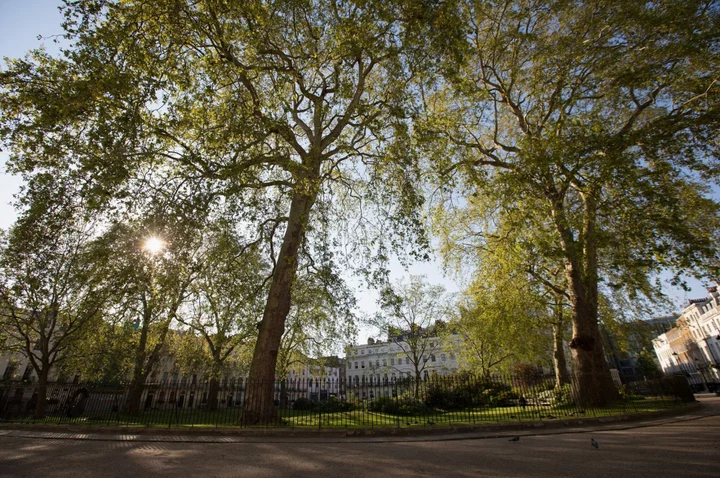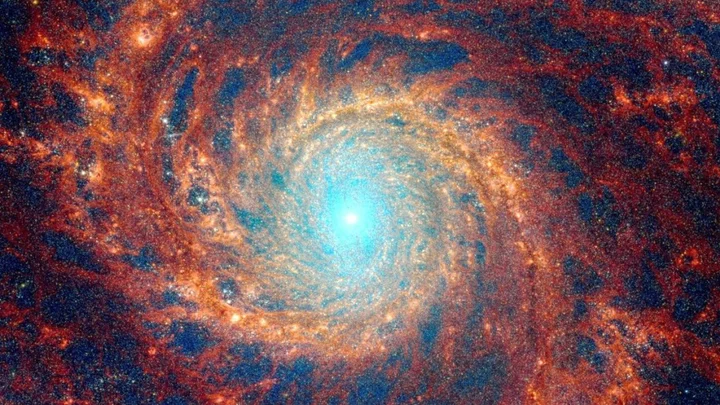
Group of premature babies evacuated from Gaza into Egypt
CAIRO (Reuters) -A first group of prematurely born babies who were evacuated from hospital in the Gaza Strip crossed into
2023-11-20 19:53

Shaftesbury Rethinks London Portfolio Sale as Bids Fall Short
Shaftesbury Capital Plc has scrapped plans to sell a portfolio of properties in London’s Fitzrovia district after bids
2023-11-20 19:27

Marketmind: Thanksgiving starters of AI and oil
A look at the day ahead in U.S. and global markets from Mike Dolan. Thanksgiving may make for a clipped
2023-11-20 19:25

NFL BetMGM Bonus Code: Win $200 for Eagles vs. Chiefs Tonight!
Turn a $10 bet into $200 in bonus bets in an instant at BetMGM. Read more to learn how you can use your bonus bets on Monday Night Football tonight.
2023-11-20 19:21

Jamie Lynn Spears ridiculed for telling I'm a Celeb viewers what she's 'best known' for
Jamie Lynn Spears is a campmate on this year's I'm a Celebrity Get Me Out of Here! but her introduction video where she says what she is best known for has left viewers raising their eyebrows. In the clip, the 32-year-old - who is the younger sister of a certain pop star - introduces herself by name and adds that she is "best known for being an actress and singer". While some may recognise her from her Nickelodeon show Zoey 101 from back in the day (2005-2008), most of us know as Britney Spears's little sister. Meanwhile, Spears also explained her reason for going into the jungle. "There is literally every misconception you can have on a person about me so I don’t take any of it seriously," she said. “But I do think going on I’m A Celebrity will be a nice way for people to see the real me. This is an opportunity to be myself and do something really cool and have some awesome experiences in the meantime.” However, viewers quickly took to social media to roast Spears for her "best known" comment, and pointing out that Spears' fellow campmates had referred to her as "Britney's sister". So how does Spears feel about the Bushtucker Trials? "Everything I have seen I have been afraid of. Absolutely every one of these trials I am dreading. I haven’t looked at any of them and thought, ‘Oh cool, I could do that one’. This is going to be terrifying," she said. Following last night's show, viewers shared how they will be voting for Spears to do the dreaded trials - so it looks like she could be in for a bumpy ride in the jungle... Well good thing Spears has shared in her pre-jungle interview that her best quality is "the fact that it takes a lot to hurt [her] feelings". "Unless you are my children or my immediate family, nothing is going to hurt me. I can take a lot of s*** and it doesn’t get me down, so I really think it’s a good quality to have in a place where a lot of stuff is thrown at you!" she said. I'm a Celebrity Get Me Out of Here! is on every night except Saturdays at 9pm on ITV1 and ITVX. How to join the indy100's free WhatsApp channel Sign up to our free Indy100 weekly newsletter Have your say in our news democracy. Click the upvote icon at the top of the page to help raise this article through the indy100 rankings.
2023-11-20 18:50

Scholz Promises €4 Billion for EU-Africa Climate Initiatives
German Chancellor Olaf Scholz pledged €4 billion ($4.4 billion) for the Africa-EU Green Energy Initiative through 2030 and
2023-11-20 18:29

Scientists discover fluffy 'alien' planet where it rains sand
Experts have discovered a fluffy “alien” planet where it rains sand in stunning new observations from the James Webb Space Telescope. The bizarre-looking planet is officially known as exoplanet WASP-107b and has a cloud of silicate sand that exists high within its atmosphere giving it its strange fluffy appearance. NASA’s James Webb Space Telescope (JWST) has been responsible for some astounding findings since it was launched in 2021, including a mysterious galaxy shaped like a question mark. Now, observations made by the telescope have been used by experts who have been able to determine the atmospheric composition of the exoplanet that was pictured. A team of European astronomers found that water vapour, sulfur dioxide and silicate sand clouds existed in the exoplanet’s diverse atmosphere. The exoplanet WASP-107b is one of the lowest-density planets that astronomers are aware of. To put it into context, it is the same size as Jupiter, but has just 12 per cent of Jupiter’s mass. Thanks to its low density, it has allowed scientists to take a deeper look into the planet’s atmosphere, exploring 50 times deeper than would be possible with denser planets. The discovery of sulfur dioxide was a surprise because the host star it orbits only emits a small amount of high-energy light photons. But, its low-density atmosphere allows the photons to penetrate WASP-107b’s atmosphere where the chemical reaction that creates sulfur dioxide can occur. They also discovered that it essentially rains sand on the exoplanet due to the presence of clouds high in the atmosphere made up of fine silicate particles. Experts believe the clouds of sand form in the same way as rain does on Earth as the droplets continually fall and condense back into cloud form. The lead author of the study, Leen Decin from Katholieke Universiteit Leuven in Belgium, explained: “JWST is revolutionizing exoplanet characterisation, providing unprecedented insights at remarkable speed.” She added: “The discovery of clouds of sand, water, and sulfur dioxide on this fluffy exoplanet… is a pivotal milestone. It reshapes our understanding of planetary formation and evolution, shedding new light on our own solar system.” How to join the indy100's free WhatsApp channel Sign up to our free indy100 weekly newsletter Have your say in our news democracy. Click the upvote icon at the top of the page to help raise this article through the indy100 rankings.
2023-11-20 18:29

'Not even in my control': Iman Vellani isn't bothered by The Marvels failing at the box office
Iman Vellani isn't concerned that her film 'The Marvels' has been a box office disaster as she doesn't feel it is a problem she can solve.
2023-11-20 18:28

Arsenal & Man Utd on alert as striker's agent confirms plans for January transfer
The agent of Santos striker Marcos Leonardo has confirmed the Arsenal & Man Utd target will leave the club in January.
2023-11-20 18:19

Japan to Start Digital Securities Trading From Next Month
Osaka Digital Exchange Co. will begin Japan’s first trading of digital securities next month in the form of
2023-11-20 18:00

'Lost City' deep in the Atlantic is like nothing else we've ever seen on Earth
The reality of what lies within our oceans has fascinated people since time immemorial, so it’s no wonder we’ve created countless myths about the watery depths. But step aside, Atlantis, scientists have discovered a real Lost City beneath the waves, and this one is teaming with life. The rocky, towering landscape is located west of the Mid-Atlantic Ridge mountain range, hundreds of metres below the surface of the Atlantic Ocean, and consists of massive walls, columns and monoliths stretching more than 60 metres (200ft) tall. To be clear, it’s not the home of some long-forgotten human civilisation, but that doesn’t make its existence any less significant. The hydrothermal field, dubbed the “Lost City” upon its discovery in the year 2000, is the longest-lived venting environment known in the ocean, Science Alert reports. Nothing else like it has ever been found on Earth, and experts think it could offer an insight into ecosystems that could exist elsewhere in the universe. For more than 120,000 years, snails, crustaceans and microbial communities have fed off the field’s vents, which spout out hydrogen, methane and other dissolved gases into the surrounding water. Despite the absence of oxygen down there, larger animals also survive in this extreme environment, including crabs, shrimps and eels. Although, they are, admittedly, rare. The hydrocarbons produced by its vents were not created by sunlight or carbon dioxide, but by chemical reactions way down on the seafloor. This is how life on our planet may have originated some 3.7 billion years, and how it could be formed on others. "This is an example of a type of ecosystem that could be active on Enceladus or Europa right this second," microbiologist William Brazelton told The Smithsonian back in 2018, referring to the moons of Saturn and Jupiter respectively. "And maybe Mars in the past." The tallest of the Lost City’s monoliths has been named Poseidon, after the Greek god of the sea, and it measures more than 60 metres high. Meanwhile, just northeast of the tower, is a cliffside where the vents “weep” with fluid, producing "clusters of delicate, multi-pronged carbonate growths that extend outward like the fingers of upturned hands", according to researchers at the University of Washington. There are now calls for the Lost City to be listed as a World Heritage site to protect the natural phenomenon, particularly given humans’ propensity to destroy precious ecosystems. Back in 2018, it was confirmed that Poland had won the rights to mine the deep sea around the thermal field. And whilst, in theory, the Lost City would not be touched by such works, as Science Alert notes, the destruction of its surroundings could have unintended consequences. Sign up for our free Indy100 weekly newsletter Have your say in our news democracy. Click the upvote icon at the top of the page to help raise this article through the indy100 rankings
2023-11-20 17:57

Orlen to Buy Kufpec’s Assets in Norway for $445 Million
Poland’s largest refiner Orlen SA agreed to purchase oil and gas producing assets on the Norwegian continental shelf
2023-11-20 17:53
